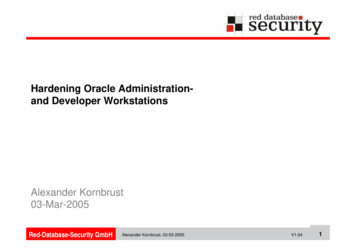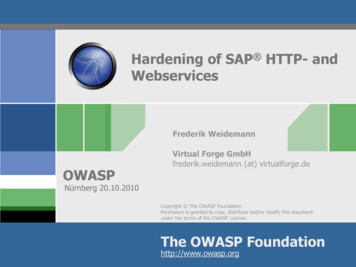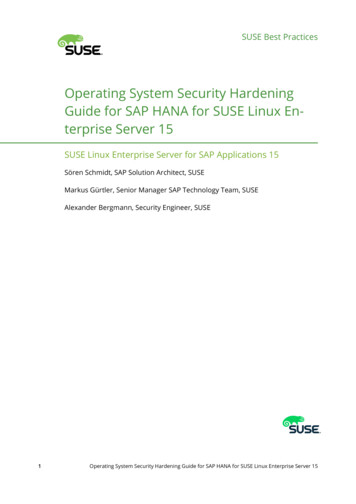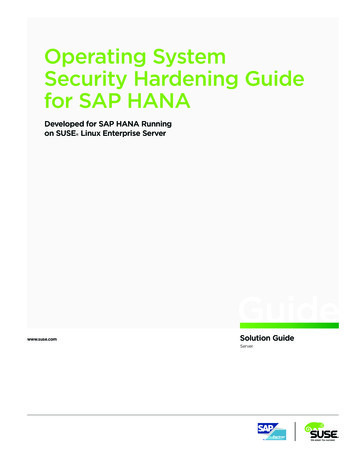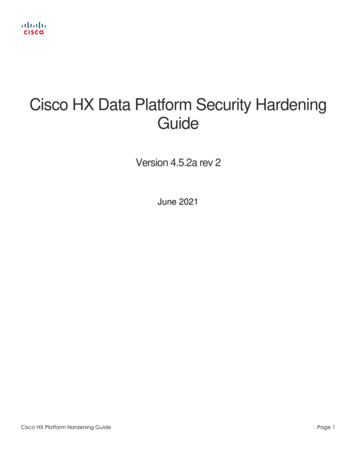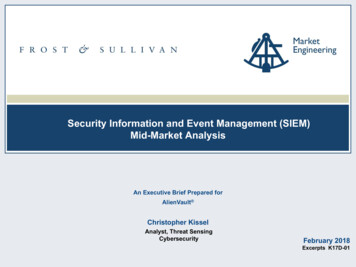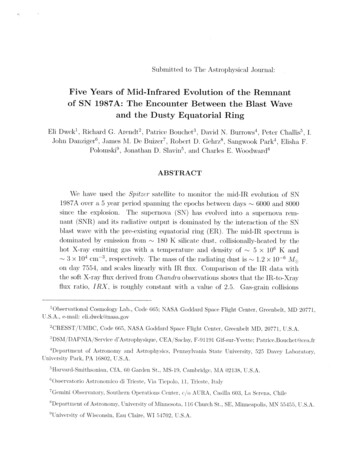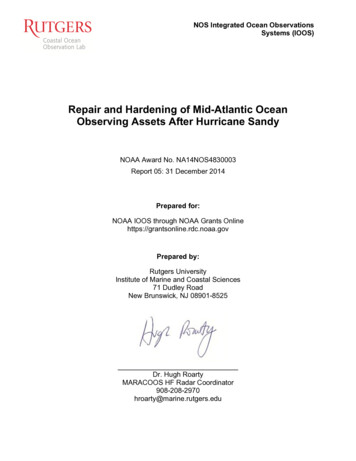
Transcription
NOS Integrated Ocean ObservationsSystems (IOOS)Repair and Hardening of Mid-Atlantic OceanObserving Assets After Hurricane SandyNOAA Award No. NA14NOS4830003Report 05: 31 December 2014Prepared for:NOAA IOOS through NOAA Grants Onlinehttps://grantsonline.rdc.noaa.govPrepared by:Rutgers UniversityInstitute of Marine and Coastal Sciences71 Dudley RoadNew Brunswick, NJ 08901-8525Dr. Hugh RoartyMARACOOS HF Radar Coordinator908-208-2970hroarty@marine.rutgers.edu
Sandy Supplemental Monthly Status ReportNOAA Award #NA14NOS4830003Reporting Period: Q4 2014Submitted: Jan. 2015INTRODUCTIONSeventeen High Frequency radars were damaged within the Mid Atlantic RegionalAssociation Coastal Ocean Observing System when Hurricane Sandy passed throughthe region in October 2012. The objective of this work is to repair and harden theseobserving system assets as well as some computer and ADCP assets lost duringSandy. The benefits of this work will increase the coverage and data quality of thesurface current measurements in the region. The US Coast Guard uses the surfacecurrents operationally for search and rescue, and the NOAA Office of Response andRestoration uses them for oil spill response. Other users of the data include NewJersey and Massachusetts Department of Environmental Protection offices, countyhealth offices and Mid Atlantic Fishery Management Council. The technical networksthat will be leveraged are the Mid-Atlantic Regional Association Coastal OceanObserving System, NOAA National High Frequency Radar Network, DHS NationalCenter for Secure and Resilient Maritime Commerce and the NJ Board of Public UtilitiesRadar Network.Dr. Hugh Roarty and Mr. Ethan Handel prepared the report.2
Sandy Supplemental Monthly Status ReportNOAA Award #NA14NOS4830003Reporting Period: Q4 2014Submitted: Jan. 20151. PROGRAM INFORMATION AND HIGHLIGHTSDuring the 4th quarter of 2014, the following progress was made:A. ProcurementThe work on the radar work is winding down as all the planned radar purchases havebeen made and delivered. A one day CODAR retreat took place on September 15th,2014 to discuss future resiliency and improvement plans for Sandy affected sites. Weare in the process of compiling the notes from this workshop and will share the results inthe next progress report.Much progress has been made with installing the newequipment and also planning resiliency practices for the future to harden the network.B. Site InstallationsDuring the fourth quarter of 2014 the following progress was achieved:1.2.3.4.Installation of full 13 MHz system in Bradley Beach, NJ (BRAD)Installation of antenna at the Slaughter Beach, DE station (SLTR).Installation of repaired receiver at Loveladies, NJ (LOVE).Different methods of antenna calibrations. A paper was accepted to the IEEECurrent, Waves and Turbulence Measurement Conference entitled“Evaluation of Three Antenna Pattern Measurements for a 25 MHz SeaSondeIncluded in the following sections on the next page are photos of the new siteinstallations and upgrades. Each site shows the new hardware (SeaSonde antenna,AIS antenna, or SeaSonde chassis).1. Bradley Beach, NJ (BRAD)On December 18th, a new 13.45MHz site, named BRAD, was installed in BradleyBeach, NJ, as a replacement for the former BELM site (Belmar, NJ). The BELM sitehad been located on the private fishing pier of the Belmar Fishing Club, but it wasseverely damaged in Hurricane Sandy and repairs have yet to be completed to the pier.So we sought permission from a neighboring town Bradley Beach and were grantedpermission to locate the equipment at a bathing facility located near the beach.3
Sandy Supplemental Monthly Status ReportNOAA Award #NA14NOS4830003Reporting Period: Q4 2014Submitted: Jan. 2015Figure 1: The waterproof, insulated, and air-conditioned electronics enclosure.Figure 2: Hardware4inside enclosure- including transmitter, receiver, computer, and UPS.
Sandy Supplemental Monthly Status ReportNOAA Award #NA14NOS4830003Reporting Period: Q4 2014Submitted: Jan. 2015Figure 3: New 13MHz combined transmit/receive antenna at BRAD site.2. Slaughter Beach, DE (SLTR)The antenna at Slaughter Beach was damaged during Sandy. Delaware had a spareantenna available that was purchased through MARACOOS funds. This spare antennawas installed shortly after Sandy and the damaged antenna was sent to CODAR Oceansensors for repair. A new antenna was purchased for the Slaughter Beach site. It wasinstalled at the Cape Henlopen, DE site as the previous antenna developed problems.Rutgers provided assistance to University of Delaware with installation of a new 25MHzcombined transmit/receive antenna at the HLPN site in Cape Henlopen State Park, DE.The antenna was installed December 2014.Figure 4: New antenna installed at Cape Henlopen, DE.5
Sandy Supplemental Monthly Status ReportNOAA Award #NA14NOS4830003Reporting Period: Q4 2014Submitted: Jan. 2015Figure 5: New base constructed for the antenna.3. Loveladies, NJ (LOVE)On October 14th, the 5MHz dual-transmit site LOVE had its receiver re-installed aftergetting a soldering problem in its T/R module repaired by CODAR Ocean Sensors.Phase tuning for proper coupling of the two antennas' transmit signals was conducted,and an AIS receiver was also installed at the site for use in creating AIS-based AntennaPattern Measurements (APM).B. Site InventoryAs a way of keeping a record of all of the serial numbers located at each site, Rutgerscreated a spreadsheet as a method of organization. Every month has an inventory tabto assist in tracking when equipment was swapped and also when a piece of equipmentgets sent back to CODAR for repairs.The next page shows the inventory list of equipment and software keys installed up tothe end of December where the fourth quarter ends. The highlighted rows indicate thesites being repaired due to the damage from Sandy. On the bottom of the sheet is a listof spare equipment, along with current RMAs that are in the process of being repairedby CODAR6
Sandy Supplemental Monthly Status ReportNOAA Award #NA14NOS48300035 96201319720131642001662006183200149200039 (DualRx for2007189(DualRx for200033200105913 00412025 :orangefont fontgreen AGfont blue@redCODARfont Not @Tx29814 - 5/139814TxforLOVEDual98013Upgrade:13/25 200033 2010270Multi-freq- CODARvan20102702013403CODARGoing to2013403Going toOperating System CODAR softwareOS X 10.6.8R7OS X 10.6.8R7 U2OS X 10.6.2R7 U1OS X 10.9.4R7OS X 10.9.5R7 U1OS X 10.9.5R7 U2OS X 10.9.5R7 U1OS X 10.9.5R7 U2OS X 10.10R7 U2OS X 10.9.5R7 U1OS X 10.9.4OS X 10.10OS X 10.9.2OS X 10.9.4OS X 10.9.4OS X 10.9.4OS X 10.9.4R7 U2R7 U2R7 U2R7 U1R7 U1R7 U1R7 U1OS X 10.9.4OS X 10.10R7 U2R7 6201421920142182013404 LOVEReporting Period: Q4 2014Submitted: Jan. 2015Radial 267101179839540429Elliptical KeyMDA S Pattern Key501487367648297 801306075359955801179019472087801486247965777AIS 1589026286115801362240217929 FTQ9RAIS801731738028269208433101015963119145 301487538699713 2007271Ethan desk Ethan desk 1017589598286953011865844814552011100No TagNo MHz) MHz 101916739562707200056-5101321724572671- -? 301504057130205 - 073 (13MHZ)- Going 1014303391935452013200-13MHz 776565521501187042322183UPSUPS ModelWPS, TrippLiteWPS, TrippLiteWPS, TrippLiteWPS, TrippLiteWPS, TrippLiteWPS, TrippLiteWPS, TrippLiteWPS Vi, SMART1500RMXL2UaWPS Vi, SMART1500RMXL2UaWPS Vi, SU1500RTXL2UaWPS Vi, SU2200RTXLCD2UWPS Vi, SU1500RTXL2UaWPS Vi, SU2200RTXLCD2UWPS Vi, SMART1500RM2UWPS, TrippLiteWPS Vi, SU2200RTXLCD2UWPS, APCWPS Vi, SMX1500RM2UNCWPS, TrippLiteWPS Vi, SMART1500RM2UWPS, TrippLite w/ backup WPS Vi, SU1500RTXL2UA, BP48V24-2UWPS, TrippLiteWPS Vi, SU2200RTXLCD2UWPS, TrippLiteWPS Vi, SU1500RTXL2UaWPS, TrippLiteWPS, TrippLiteAIS rxWPS Vi, SMART1500RMXL2UAWPS Vi, SMART1500RMXL2UABattery BackupNetwork :22:BF:4A00:06:67:24:83:F2208576208435Lightning 4102201410320141072011029- CODAR vangoing to NAVYFigure 6: Rutgers HF radar inventory as of January 2015.7
Sandy Supplemental Monthly Status ReportNOAA Award #NA14NOS4830003Reporting Period: Q4 2014Submitted: Jan. 2015C. Antenna CalibrationsAntenna pattern calibrations were performed at seven of the sites to correct for bearingerrors at the radial level. Walking, boat, and AIS-generated patterns will be compared inthe following sections. Loop 1 is depicted as the red line and loop 2 is shown as theblue line.1. BRADAn AIS antenna and receiver were also installed as part of the BRAD siteequipment. Initial AIS-based CODAR loop measurements show the systemwill likely be very useful for future calibration work.Figure 7: LOOP file from Bradley Beach AIS pattern.Figure 8: Bradley Beach AIS pattern plotted on a map of New Jersey.8
Sandy Supplemental Monthly Status ReportNOAA Award #NA14NOS4830003Reporting Period: Q4 2014Submitted: Jan. 20152. LOVEA walking pattern for Loveladies was performed on October 29, 2014. The results areshown in Figure 9. We attempted to create an AIS pattern for this station but wereunsuccessful in creating a valid pattern. We are working with CODAR Ocean Sensorsto remedy this deficiency.Figure 9: LOOP file from Loveladies walking pattern.3.BRNTOn October 1, 2014 a walking APM was conducted at the BRNT site, in Brant Beach,NJ. This was performed as a training exercise as Carlos Garcia Moreno from Universityof Puerto Rico and CARICOOS was at Rutgers for HF radar training. The patternshows only minimal loop distortion, and has been processed and installed on the site'scomputer.Figure 10: LOOP file from the Brant Beach walking pattern.9
Sandy Supplemental Monthly Status ReportNOAA Award #NA14NOS4830003Reporting Period: Q4 2014Submitted: Jan. 2015!Figure 11: Brant Beach walking pattern placed on a map of New Jersey.4. SILDOn October 21st, an AIS-based APM was processed from one day's worth of AIS datafrom vessels in Raritan Bay and around New York Harbor. This pattern also shows onlyminimal loop distortions, and has been processed and installed on the site's computer.Figure 12: LOOP plot of AIS pattern from SILD.10
Sandy Supplemental Monthly Status ReportNOAA Award #NA14NOS4830003Reporting Period: Q4 2014Submitted: Jan. 2015Figure 13: Staten Island AIS pattern placed on a map of NY Harbor.Below is a table that indicates the report that included that particular antennapattern measurement type. For instance, the walking pattern for HOOK was publishedin report 3 and the AIS generated pattern was published in report 4 The entire table willbe filled out by the end of the project.Table 1: List of Rutgers Sandy repais stations with antenna pattern type and the report the pattern waspublished.%C*DCC"E3"**DFCE,D"GHFDIDC*E?JKD!"# %&' ()"* 0468; @A B 11,-./12,3 41//5 47/-2 8'&796(27,( ? 6:8( , 63/ ? 6'2%( 4'3 54686:8866666
Sandy Supplemental Monthly Status ReportNOAA Award #NA14NOS4830003Reporting Period: Q4 2014Submitted: Jan. 2015D. Data QualitySeveral QA/AC methods are implemented to analyze the quality of the datareaching Rutgers and the National Network. Radial vector count, average radialvelocities, radial coverage, and data latency are just a few qualities that are examined todetermine how well a site is operating.Figure 14: Radial coverage map for the Bradley Beach radar from December 22-28, 2014.Figure 15: Radial coverage map for the Loveladies radar from November 3-9, 201412
Sandy Supplemental Monthly Status ReportNOAA Award #NA14NOS4830003Reporting Period: Q4 2014Submitted: Jan. 2015HOOK- the 5MHz dual transmit site HOOK, in Sandy Hook, NJ has been suffering frompoor data coverage, and new experiments have been planned aimed at improving thequality and consistency of data from this site.AWG Firmware Update NoteCodar Ocean Sensors issued a firmware update for the Advanced WaveformGenerator (AWG) modules inside SeaSonde Receiver units. This update wassuccessfully completed at all sites, except for SLTR, in Slaughter Beach, DE, and atBRNT, in Brant Beach, NJ. The AWG modules from those two sites were sent back toCodar Ocean Sensors for factory re-programming.13
Sandy Supplemental Monthly Status ReportNOAA Award #NA14NOS4830003Reporting Period: Q4 2014Submitted: Jan. 20152. ISSUES/RISKS & MITIGATIONBased on almost two decades of previous experience with CODAR HF-Radar siteinstallations, high level potential risks to the success of this project include:1. If the municipality, park or land owner of the potential installation site locationrefuses to allow installation of a site, then there could be delays in siteinstallation or it could force us to move the site location to a less than optimallocation.a.
Repair and Hardening of Mid-Atlantic Ocean Observing Assets After Hurricane Sandy NOAA Award No. NA14NOS4830003 Report 05: 31 December 2014 Prepared for: NOAA IOOS through NOAA Grants Online https://grantsonline.rdc.noaa.gov Prepared by: Rutgers University Institute of Marine and Coastal Sciences 71 Dudley Road New Brunswick, NJ 08901-8525 _ Dr. Hugh Roarty MARACOOS HF

